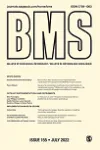 Accueil
Accueil
Mots-clés
|
Thésaurus mots-clés > Epidémiologie : variables et méthodes > Cibles > POPULATION CACHEE
POPULATION CACHEE |
Documents disponibles dans cette catégorie (107)
 Ajouter le résultat dans votre panier Faire une suggestion Affiner la recherche
Ajouter le résultat dans votre panier Faire une suggestion Affiner la recherche
Article : Périodique
FRANÇAIS : Les concepteurs d'enquêtes ayant recours à la Collecte Assistée par Téléphone et Informatique (CATI) sont confrontés à quatre types de populations : les abonnés au téléphone fixe au sein desquels il faut distinguer les inscrits sur [...]
Livre
Delve into the uncharted territory of the "hidden" drug addict - sers who are not in treatment, not incarcerated, and not officially accessible for research purposes through traditional means. AIDS and Community-Based Drug Intervention Programs [...]
Périodique
R. CARLSON ; J. WANG ; H. SIEGAL ; R. FALCK ; J. GUO | 1994Recruiting large samples from "hidden populations" of injection drug and crack-cocaine users who are not in drug treatment has been a troubling methodological problem that has increased in significance in the face of the AIDS pandemic. This arti[...]
Périodique
G. BURKHART ; KRIENER H. | 2004ENGLISH : Concern in the European Union has increased during the past years about the content of pills sold as ecstasy. However, within this context, the challenge of taking the necessary prevention measures is great - in particular to approac[...]
Périodique
D. MOORE | 2004ENGLISH : "Subculture" has been an important conceptual and methodological tool in the ethnographic study of drug use and drug-related harm, particularly heavy drug use among marginalized populations. When researching those whose drug use is l[...]
Chapitre
T. DECORTE | 2011Within the study of drug use and addiction, specific scientific paradigms, methods and tools have dominated - epidemiology, psychiatry, neurobiology - while other approaches have remained more marginal (including anthropology, history, sociology[...]
Article : Périodique

Périodique
V. D. HOPE ; M. HICKMAN ; K. TILLING | 2005ENGLISH : Aim : To estimate the prevalence of crack cocaine use in 12 London Boroughs (and London as a whole). Setting : Twelve London Boroughs, 2000-01. Methods : (1) Covariate capture-recapture techniques applied to three data sources of sub[...]
Article : Périodique
FRANÇAIS : Cet article porte sur les carrières d'usagers de cocaïne inconnus des institutions socio-sanitaires et répressives. Il présente les résultats d'une enquête conduite par entretiens semi-directifs auprès de 50 usagers appartenant à cet[...]
Article : Périodique
Background: Incarcerations are associated with an increased risk of morbidity and mortality among people who use drugs (PWUD). In a sample of 884 PWUD, we examine and estimate the risk of incarcerations (i.e., number, duration, and most serious [...]
Périodique
W. R. DAVIS ; B. D. JOHNSON ; H. J. LIBERTY ; RANDOLPH D. D. | 2004ENGLISH : This article analyzes hidden status among crack, powder cocaine, and heroin users and sellers, in contrast to more accessible users/sellers. Several sampling strategies acquired 657 users (N=559) and sellers (N=98). Indicators of hid[...]
Bulletin : Périodique
Addiction Research and Theory, Vol.12, n°4 - August 2004 - Clinical harm reduction
F. ROTGERS, Éditeur scientifique ; F. ROTGERS, Auteur ; L. DICKSON ; J. L. DEREVENSKY ; R. GUPTA ; J. S. BAER ; P. L. PETERSON ; E. A. WELLS ; K. FROMME ; ORRICK D. ; S. PEELE | 2004Despite this "nontherapeutic" approach that characterized early harm reduction efforts in the US, there have developed a number of other more clinically and therapeutically focused approaches that can clearly be subsumed under the rubric of harm[...]
Article : Périodique
A. H. KRAL ; M. MALEKINEJAD ; J. VAUDREY ; A. N. MARTINEZ ; J. LORVICK ; W. McFARLAND ; H. F. RAYMOND |The objective of this article is to compare demographic characteristics, risk behaviors, and service utilization among injection drug users (IDUs) recruited from two separate studies in San Francisco in 2005, one which used targeted sampling (TS[...]
Article : Périodique
D. M. PAQUETTE ; J. BRYANT ; J. DE WIT |Aims: Respondent-driven sampling (RDS) is increasingly being used to sample hidden populations, such as people who inject drugs (PWIDs). This study compared samples of PWID recruited from RDS and service-based sampling methods to explore whether[...]
Article : Périodique
FRANÇAIS : La confidentialité est au coeur des relations de confiance dans la recherche ethnographique sur le terrain. Dans le passé, les services sanitaires publics fournissaient une assurance de confidentialité à ceux qui participaient à la [...]




